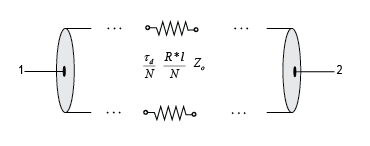txlineDelayLossy
Description
Use the txlineDelayLossy object to create a delay lossy
transmission line. You can also use the txlineDelayLossy object to model a
delay lossy transmission line in an RF system using the rfbudget object or the
RF Budget
Analyzer app.

Creation
Description
dlytxline = txlineDelayLossy
dlytxline = txlineDelayLossy(Name,Value)dlytxline = txlineDelayLossy('Z0',75) creates a delay lossy
transmission line with an impedance of 75 ohms.
Properties
Object Functions
sparameters | Calculate S-parameters for RF data, network, circuit, and matching network objects |
groupdelay | Group delay of S-parameter object or RF filter object or RF Toolbox circuit object |
noisefigure | Calculate noise figure of transmission lines, series RLC, and shunt RLC circuits |
Examples
Algorithms
The delay lossy transmission line object calculates the S-parameters for the specified frequencies. This calculation is based on the delay line's line length, resistance, and time delay. The S-parameters are calculated using the equation given.
Here, . ɑa in p is the
attenuation coefficient and β is the wave number.
The attenuation coefficient, ɑa, is related to
the loss, ɑ, by
and the wave number β is related to the time delay,
D, by
where f is the frequency range specified in the S-parameters input
argument.
Version History
Introduced in R2021a